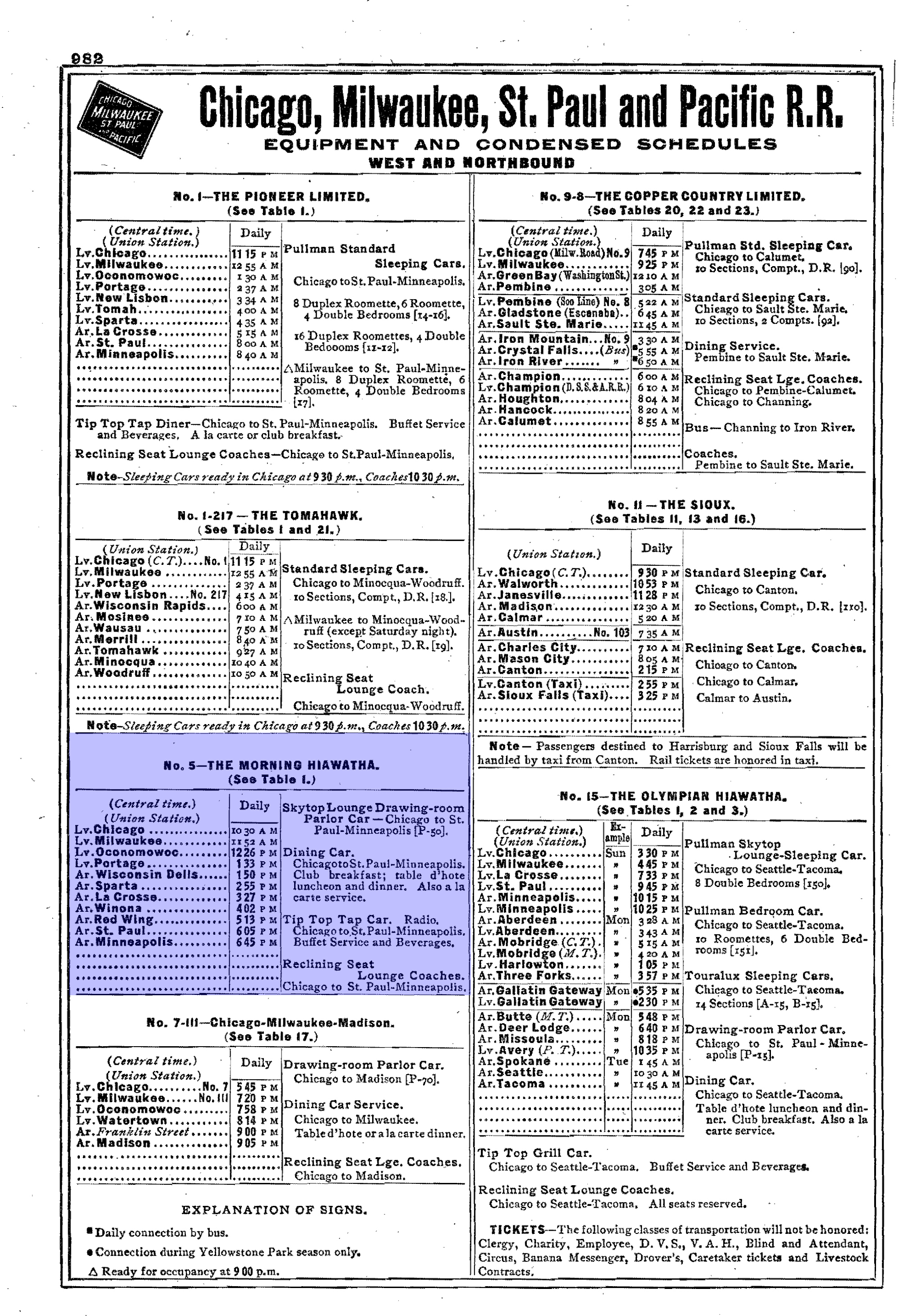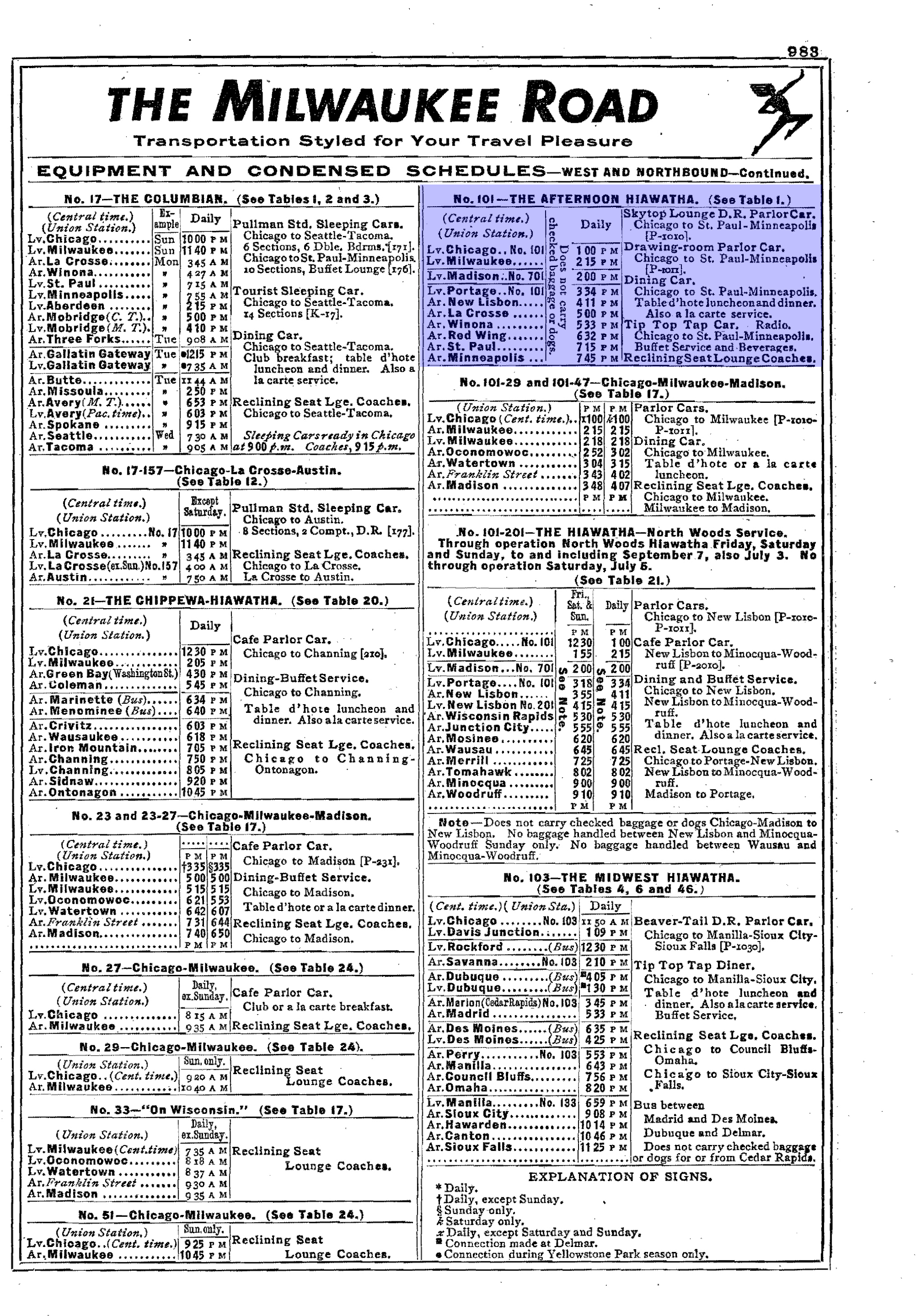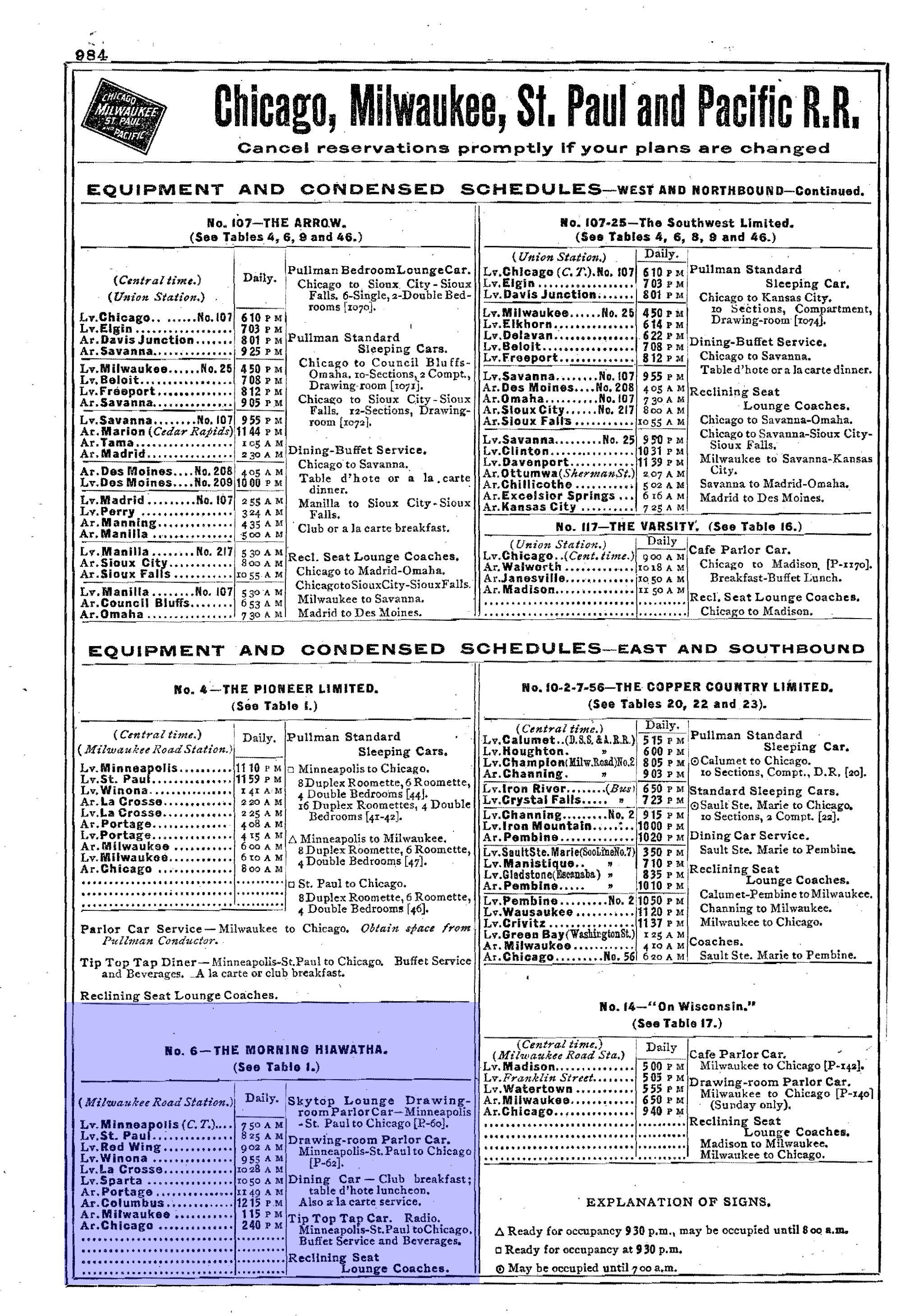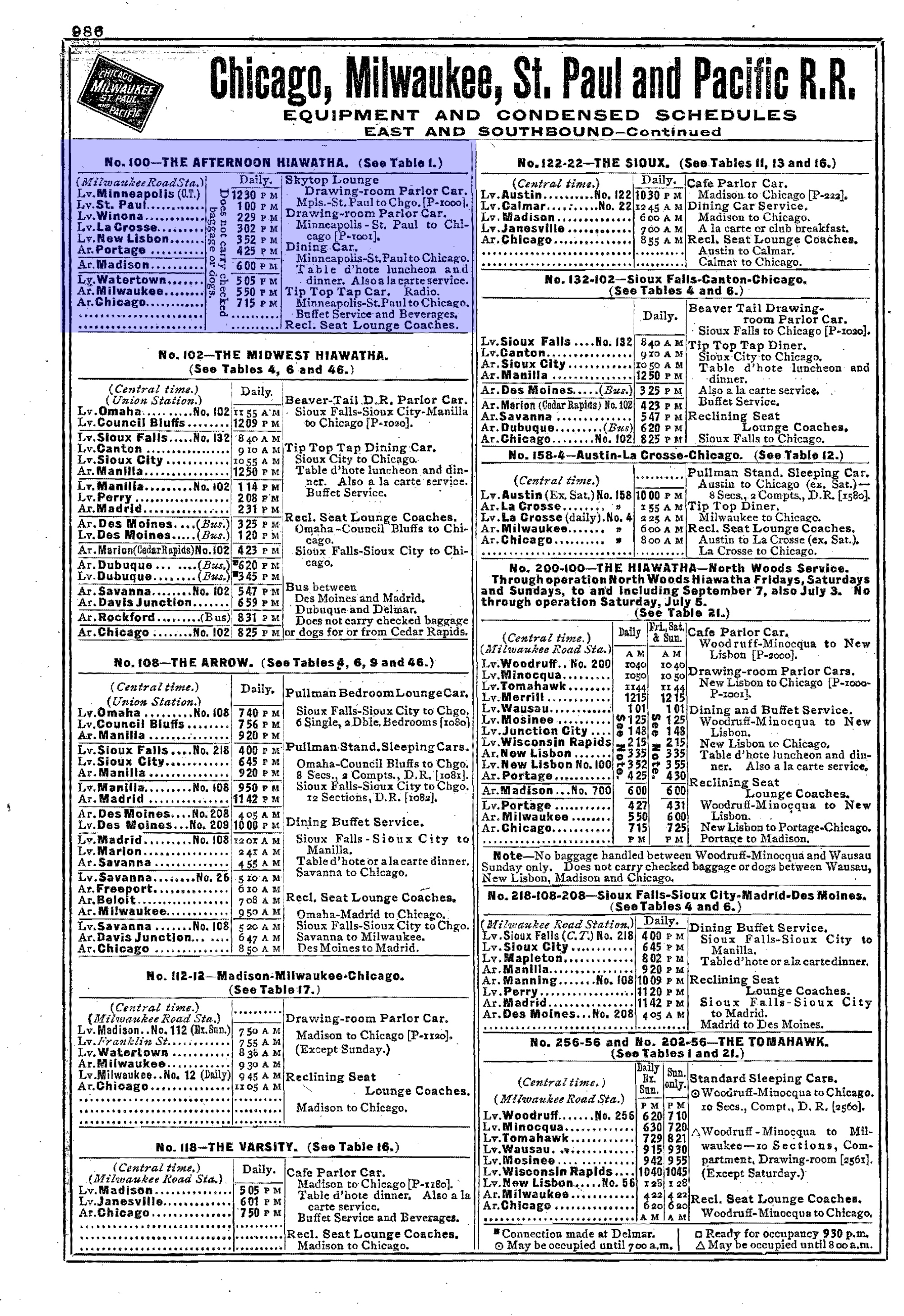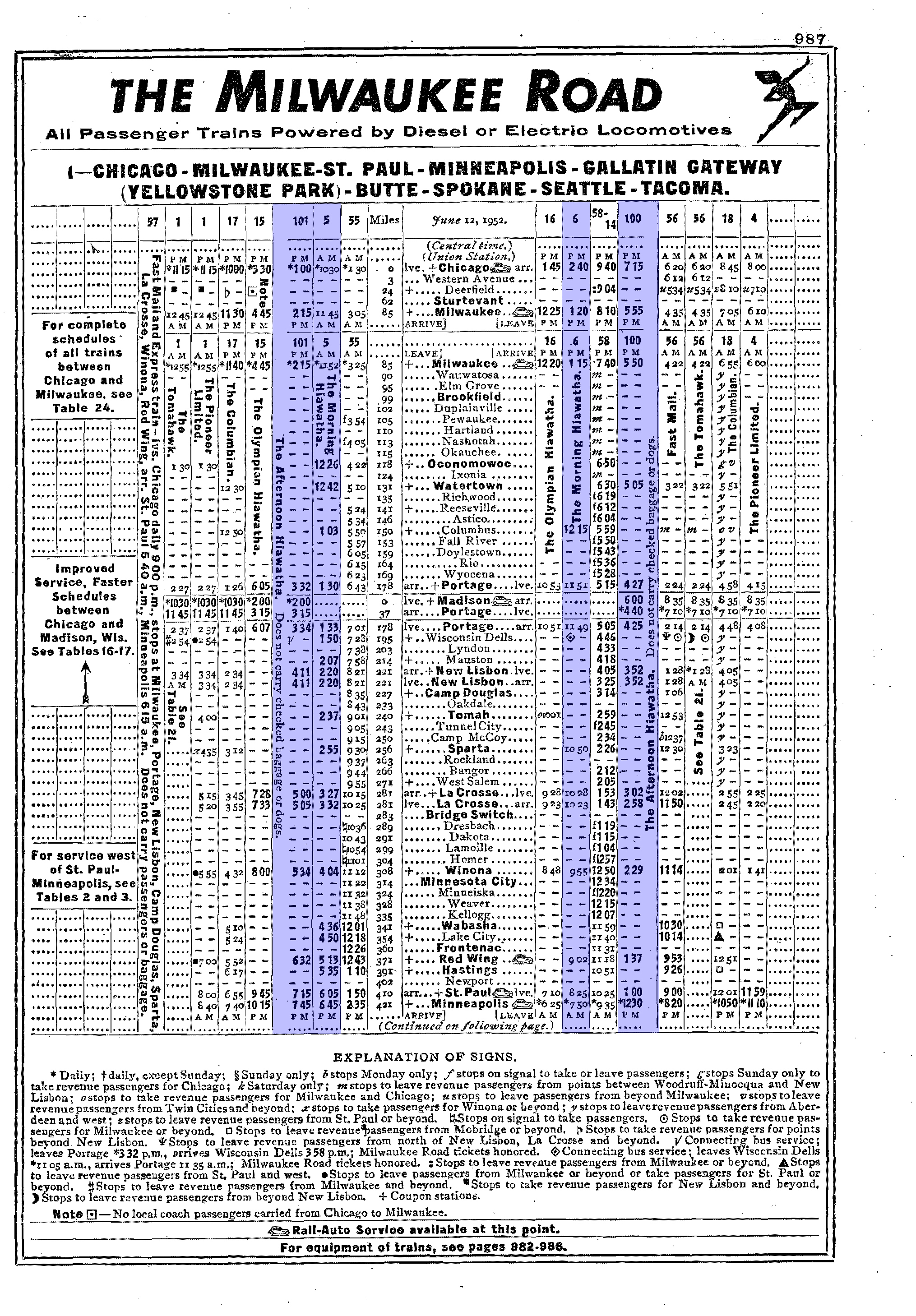"Twin Cities Hiawatha" (Train): Timetables, Consists, History
Last revised: February 24, 2o25
By: Adam Burns
In 1935 the Milwaukee Road introduced the Hiawatha, sometimes referred to as the Twin Cities Hiawatha, a passenger train that would spawn a whole fleet of famous trains by the same name.
The original operated between Chicago and the Twin Cities and officially began service on May 29, 1935; one of the first streamlined trains ever to be introduced in the U.S. For the Milwaukee, the Hiawathas were virtually the only streamlined passenger trains operated by the railroad (they certainly were the most popular and well-remembered).
The trains were both regional in nature and long-distance (Olympian Hiawatha and Midwest Hiawatha). In addition, after October, 1955 the railroad handled Union Pacific's City fleet to and from Chicago.
Originally powered by 4-4-2 Atlantic-type steam locomotives (later 4-6-4 Hudson-types) the train was entirely streamlined, including the locomotive, and home-built in the Milwaukee Road's own shops.
These trains were instantly successful, regularly clipping along at speeds topping 100 mph with hardly a bump or shudder during the ride. The Chicago-Twin Cities run could be achieved in roughly seven hours and the Milwaukee Road's trackside "Reduce to 90" signs are legendary.
Photos
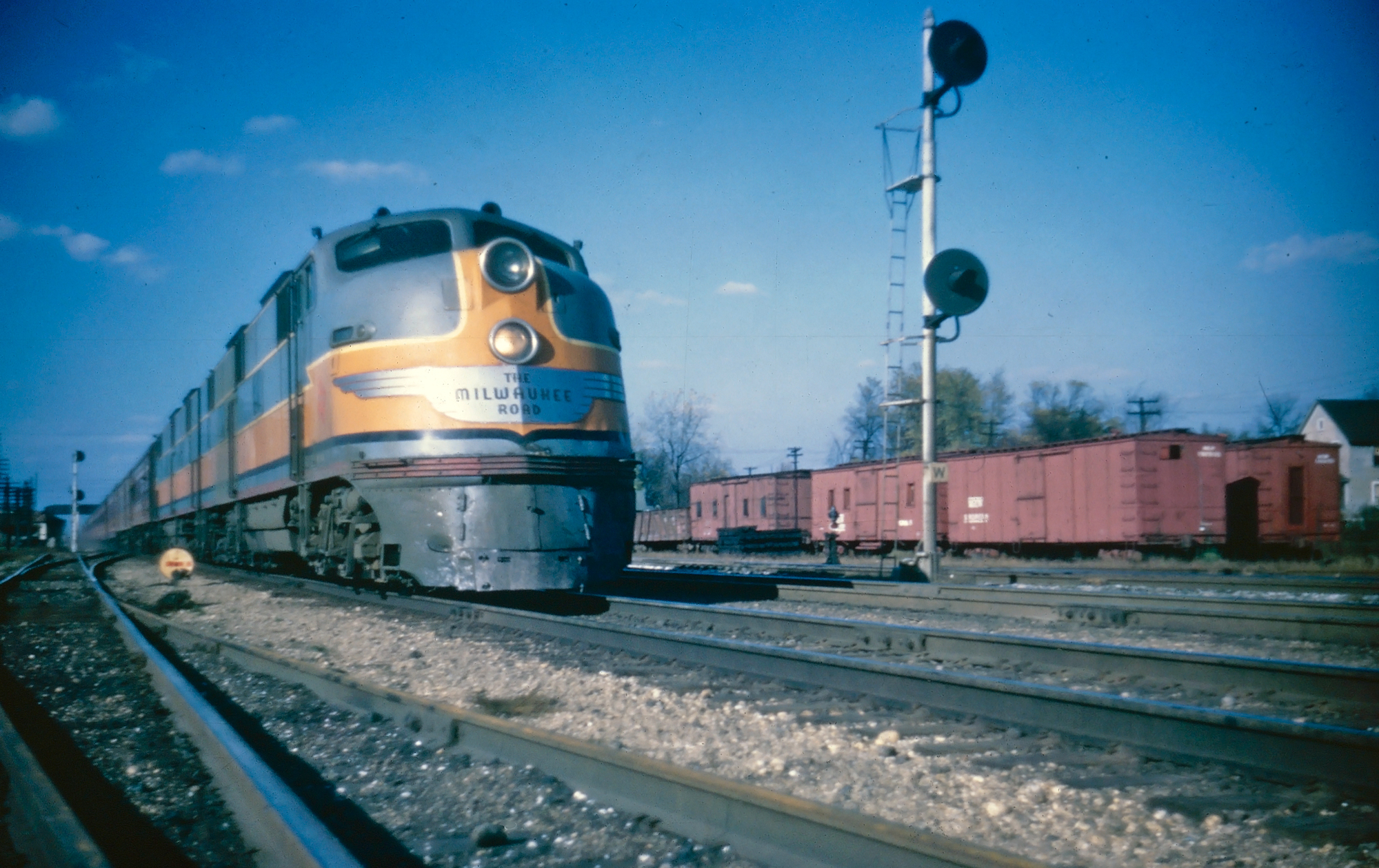 Milwaukee Road E6A #15-A is ahead of a "Twin Cities Hiawatha" at Rondout, Illinois on September 2, 1948. Photographer unknown. American-Rails.com collection.
Milwaukee Road E6A #15-A is ahead of a "Twin Cities Hiawatha" at Rondout, Illinois on September 2, 1948. Photographer unknown. American-Rails.com collection.History
The original Twin Cities Hiawatha was ingeniously conceived. Like many other famous streamlined passengers trains, which played on themes of either the geography or regional historical cultures, so too did the Hiawathas.
These trains were based from Native American tribes found in the upper Midwest. They became so successful the railroad found itself short on demand and to meet such eventually operated two versions of the train, the Morning Hiawatha and Afternoon Hiawatha.
Consist (1952)
There were eventually four other versions of the trains operated in the Midwest. These included:
- Twin Cities Hiawatha, North Woods Hiawatha (Served New Lisbon, Wisconsin to Minocqua, Wisconsin.)
- Chippewa Hiawatha (Served Chicago; Ontonagon, Michigan; and Milwaukee and Green Bay.)
- Midwest Hiawatha (From Chicago this train served both Omaha, Nebraska and Sioux Falls, South Dakota.)
However, these Midwest versions were not the only Hiawathas the Milwaukee ever operated. With the success of its regional Hiawathas, in 1947, about twelve years after the railroad first launched its Twin Cities Hiawatha the railroad introduced the streamlined Olympian Hiawatha.
At A Glance
6 Hours, 35 Minutes (Westbound) 6 Hours, 45 Minutes (Eastbound) |
|
101/5 (Westbound) 100/6 (Eastbound) | |
Union Depot (St. Paul) Union Station (Chicago) |
This particular train was meant to fully compete with the Great Northern and Northern Pacific for rail travel to and from the Pacific Northwest (the Milwaukee had operated the transcontinental Olympian and Columbian since 1911 over its Pacific Extension but these trains used heavyweight equipment and were pulled by conventional steam locomotives).
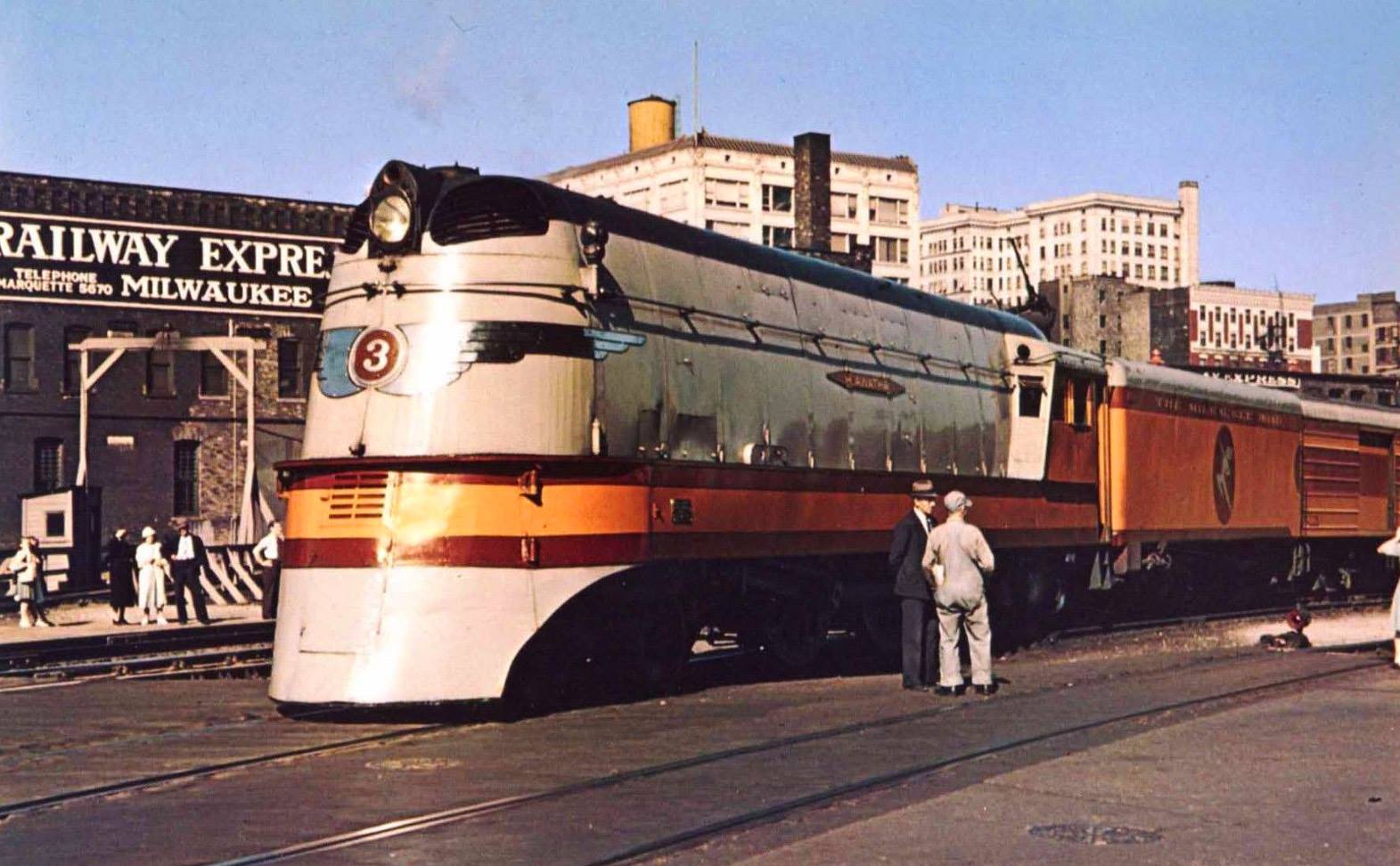 One of the Milwaukee Road's lightning fast Class A 4-4-2's, #3 (according to Jim Scribbins' book, "The Hiawatha Story," she was outshopped from Alco on May 21, 1936), is seen here during a quick station stop at Milwaukee, Wisconsin with the "Hiawatha" (Chicago - St. Paul/Minneapolis) on September 17, 1939. The Atlantic normally cruised at 100 mph and covered the entire 409 miles from Chicago to St. Paul in just 390 minutes (6 1/2 hours). To maintain its blistering schedule the railroad allowed just 2 minutes in Milwaukee for watering and handling passengers before the train was again on its way. Richard Kindig photo.
One of the Milwaukee Road's lightning fast Class A 4-4-2's, #3 (according to Jim Scribbins' book, "The Hiawatha Story," she was outshopped from Alco on May 21, 1936), is seen here during a quick station stop at Milwaukee, Wisconsin with the "Hiawatha" (Chicago - St. Paul/Minneapolis) on September 17, 1939. The Atlantic normally cruised at 100 mph and covered the entire 409 miles from Chicago to St. Paul in just 390 minutes (6 1/2 hours). To maintain its blistering schedule the railroad allowed just 2 minutes in Milwaukee for watering and handling passengers before the train was again on its way. Richard Kindig photo.The Milwaukee Road's Hiawathas owe their creation to industrial designer Otto Kuhler, the same man who designed the Baltimore & Ohio's regal Capitol Limited and its classic royal blue, gold, and gray livery. Kuhler designed similar stunning accents on the Hiawathas.
The train featured a livery of two-tone orange and gray and the distinctive Beaver Tail parlor-observation car, a unique twist from the more traditional round-ended observations found on most other streamliners.
Timetables (1952)
The Beaver Tail parlor-observations were later replaced with the celebrated Sky Top lounge-observations, perhaps the most distinctive and dramatic observation cars ever built.
Designed by industrial designer Brooks Stevens the rear of the cars featured a beautiful solarium lounge that afforded passengers unprecedented views of the outside world (the cars were also used on the Olympian Hi).
Afternoon Hiawatha Timetable (December 7, 1969)
| Read Down Time/Leave (Train #3/Afternoon Hiawatha) | Milepost | Location | Read Up Time/Arrive (Train #2/Afternoon Hiawatha) |
|---|---|---|---|
| 12:35 PM (Dp) | 0.0 | 7:55 PM (Ar) | |
| 12:58 PM | 17 | 7:27 PM | |
| 2:01 PM (Ar) | 85 | 6:25 PM (Dp) | |
| 2:06 PM (Dp) | 85 | 6:19 PM (Ar) | |
| 2:52 PM | 131 | 5:28 PM | |
| 3:13 PM (Ar) | 150 | 5:08 PM (Dp) | |
| 3:13 PM (Dp) | 150 | 5:08 PM (Ar) | |
| 3:40 PM (Ar) | 178 | 4:41 PM (Dp) | |
| 3:42 PM (Dp) | 178 | 4:39 PM (Ar) | |
| 4:22 PM (Ar) | 221 | 3:58 PM (Dp) | |
| 4:22 PM (Dp) | 221 | 3:58 PM (Dp) | |
| 5:17 PM (Ar) | 281 | 3:01 PM (Dp) | |
| 5:21 PM (Dp) | 281 | 2:55 PM (Ar) | |
| 5:54 PM | 308 | 2:26 PM | |
| 6:24 PM | 341 | 1:52 PM | |
| 6:55 PM | 371 | 1:22 PM | |
| 7:45 PM (Ar) | 410 | 12:40 PM (Dp) | |
| 7:55 PM (Dp) | 410 | 12:35 PM (Ar) | |
| 8:00 PM (Ar) | 421 | 12:15 AM (Dp) |
The, original, and blazing fast Atlantic steam locomotives use for power likewise received the Kuhler touch. The locomotive featured shrouding over most of its exterior with the running gear partially exposed at the bottom.
Perhaps the 4-4-2's unique feature was its round, bullet-shaped, nose that included wings across its flank with the locomotive's road number featured front and center. The tender was also eye-catching as it featured a very prominent Hiawatha emblem, one of the all-time classic railroad logos ever conceived.
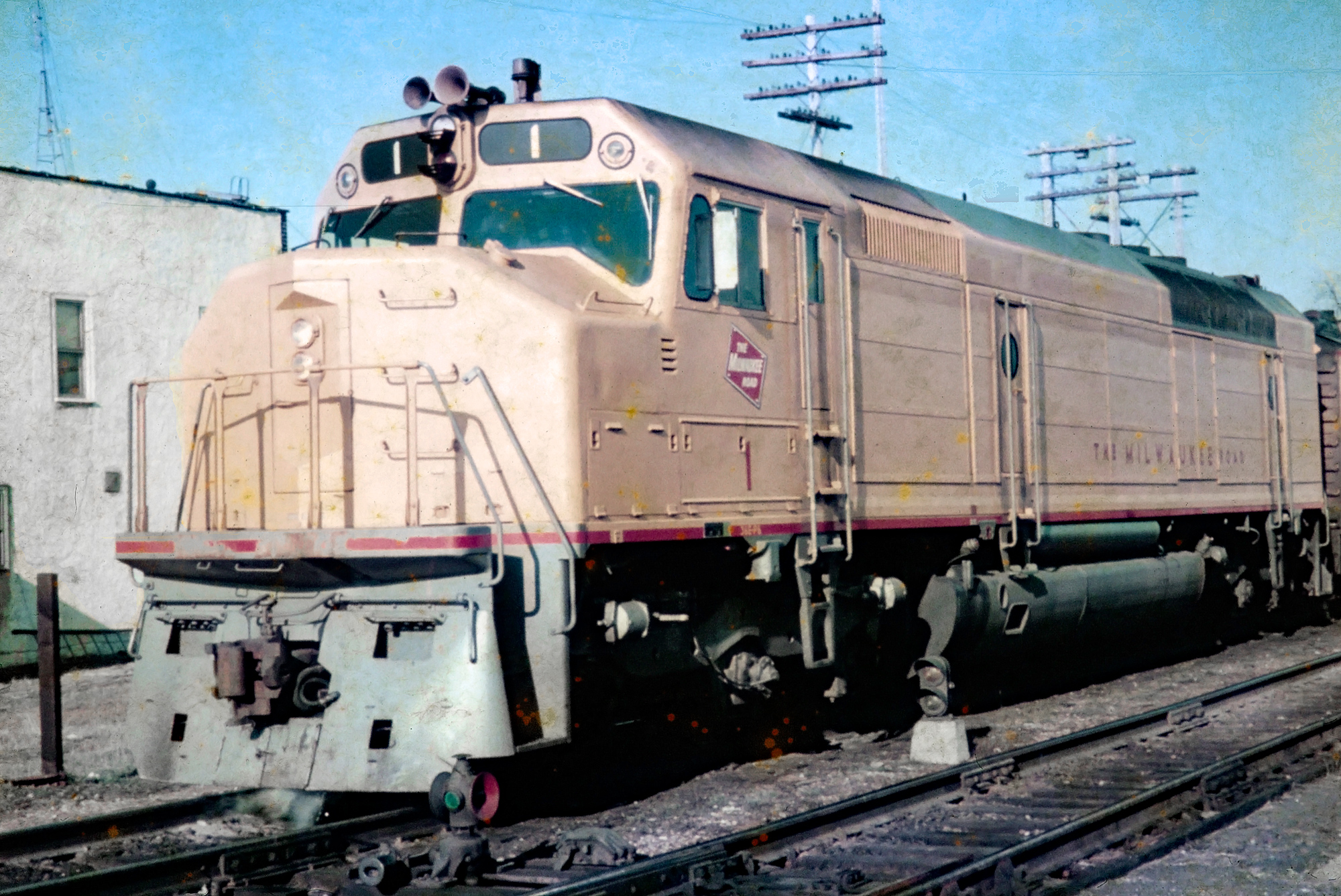 Milwaukee Road FP45 #1 with a "Hiawatha" consist at Davis Junction, Illinois in April of 1969. Fred Byerly photo. American-Rails.com collection.
Milwaukee Road FP45 #1 with a "Hiawatha" consist at Davis Junction, Illinois in April of 1969. Fred Byerly photo. American-Rails.com collection.According to the Milwaukee Road's 1938 timetable, trains #101 (westbound departing Chicago) and #100 (eastbound departing Minneapolis) could make their journey between the two cities in a flat, seven hours averaging just over 60 mph! (For an average train speed this is incredibly fast.)
The train's initial consist included the aforementioned Beaver Tail parlor, a standard parlor, drawing-room parlor, the famed "Tip Top Tap" café car, diner, and luxury coaches.
Morning Hiawatha Timetable (December 7, 1969)
(The below Morning Hiawatha timetable from the Official Guide is dated effective December 7, 1969. At this time both the Morning and Afternoon runs had notices on the schedule stating, "Application has been made to discontinue. Ask agent for details.)
| Read Down Time/Leave (Train #5/Morning Hiawatha) | Milepost | Location | Read Up Time/Arrive (Train #6/Morning Hiawatha) |
|---|---|---|---|
| 10:30 AM (Dp) | 0.0 | 3:10 PM (Ar) | |
| 10:55 AM | 17 | 2:46 PM | |
| 11:58 AM (Ar) | 85 | 1:44 PM (Dp) | |
| 12:09 PM (Dp) | 85 | 1:40 PM (Ar) | |
| 12:45 PM | 118 | 1:00 PM | |
| 1:01 PM | 131 | 12:44 PM | |
| 1:22 PM (Ar) | 150 | 12:25 PM (Dp) | |
| 1:22 PM (Dp) | 150 | 12:25 PM (Ar) | |
| 1:49 PM (Ar) | 178 | 11:57 AM (Dp) | |
| 1:55 PM (Dp) | 178 | 11:55 AM (Ar) | |
| 2:32 PM | 214 | ||
| F 2:41 PM (Ar) | 221 | ||
| F 2:41 PM (Dp) | 221 | ||
| 3:03 PM | 240 | 11:01 AM | |
| 3:23 PM | 256 | 10:43 AM | |
| 3:48 PM (Ar) | 281 | 10:19 AM (Dp) | |
| 3:55 PM (Dp) | 281 | 10:14 AM (Ar) | |
| 4:30 PM | 308 | 9:44 AM | |
| 5:04 PM | 341 | ||
| 5:19 PM | 354 | ||
| 5:42 PM | 371 | 8:46 AM | |
| 6:05 PM | 391 | ||
| 6:40 PM (Ar) | 410 | 8:05 AM (Dp) | |
| 6:55 PM (Dp) | 410 | 7:50 AM (Ar) | |
| 7:20 PM (Ar) | 421 | 7:30 AM (Dp) |
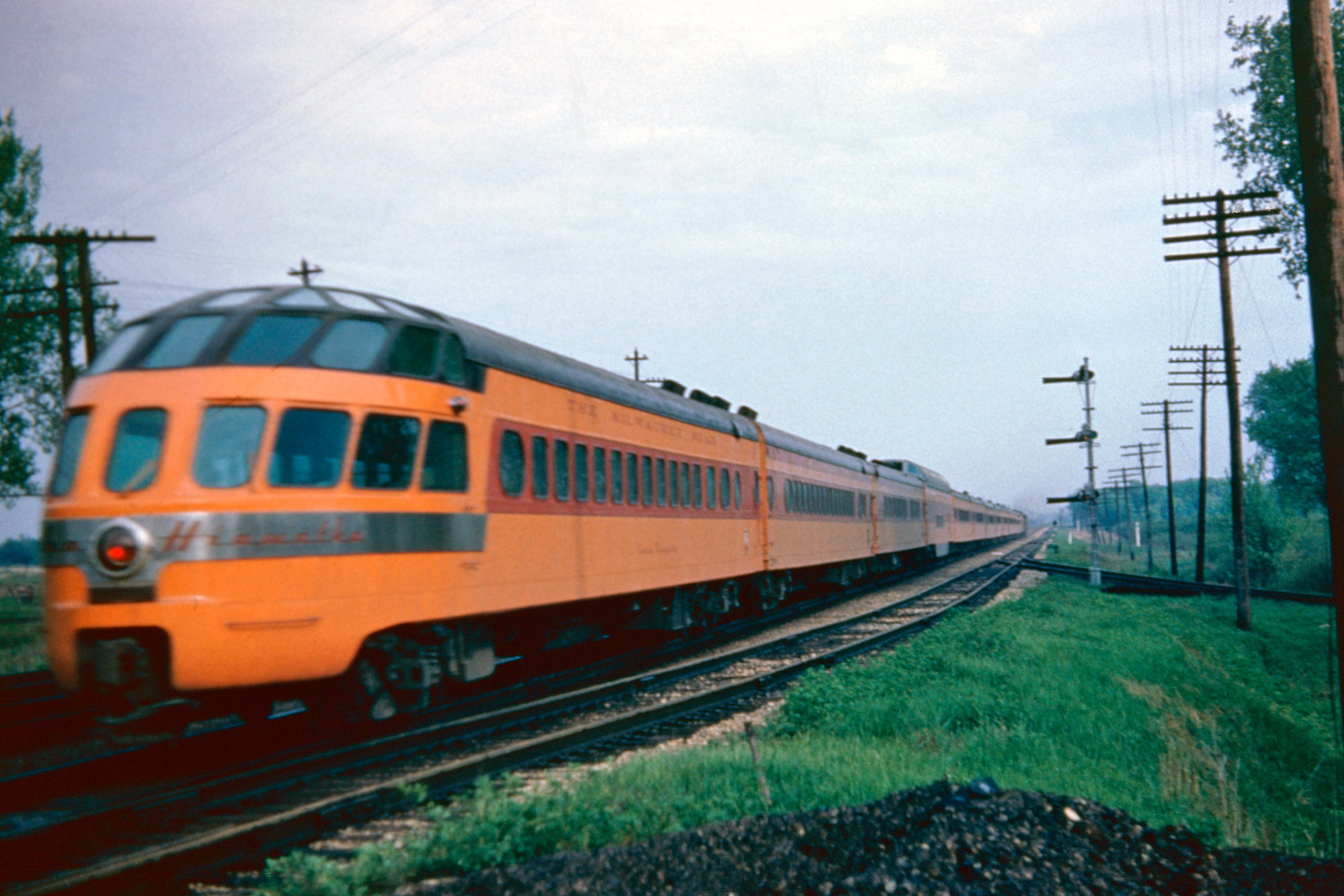 Milwaukee Road Skytop lounge-observation "Coon Rapids" brings up the tail end of the 'Twin Cities Hiawatha' near Portage, Wisconsin; May 23, 1953. American-Rails.com collection.
Milwaukee Road Skytop lounge-observation "Coon Rapids" brings up the tail end of the 'Twin Cities Hiawatha' near Portage, Wisconsin; May 23, 1953. American-Rails.com collection.Final Years
For the next 45 years the regional Hiawathas would soldier on under the Milwaukee Road, although after 1948 the railroad parked its venerable steam locomotives in favor of diesels using EMD's streamlined E6s and E9s.
The train was actually so popular that the railroad continued to upgrade it through 1952 and included services such as Super Dome service.
Today, one can no longer find the Midwest Hiawatha or Twin Cities Hiawatha hustling travelers across the Heartland, and Milwaukee's route to Omaha, Nebraska and Sioux Falls, South Dakota is now mostly an empty, weed-covered path slowly being reclaimed by Mother Nature.
However, a semblance of this once legendary service
continues on under Amtrak offering Hiawatha regional trains between Milwaukee and Chicago.
Sources
- Johnston, Bob and Welsh, Joe. Art Of The Streamliner, The. New York: Andover Junction Publications, 2001.
- Murray, Tom. Milwaukee Road, The. St. Paul: MBI Publishing, 2005.
- Schafer, Mike and Welsh, Joe. Streamliners, History of a Railroad Icon. St. Paul: MBI Publishing, 2003.
- Scribbins, Jim. Hiawatha Story, The. Minneapolis: University of Minnesota Press, 2007.
- Scribbins, Jim. Milwaukee Road Remembered. Minneapolis: University Of Minnesota, 2008 (Second Edition).
- Solomon, Brian and Gruber, John. Milwaukee Road's Hiawatha's, The. St. Paul: Voyageur Press, 2006.
Contents
Afternoon Hiawatha Timetable (December 7, 1969)
Recent Articles
-
Indiana - Whiskey - Train Rides
Dec 23, 25 06:40 PM
Whether you're a local resident or a traveler looking to explore Indiana from a unique perspective, hopping on a whiskey train ride is a journey worth considering. -
California - Wine Tasting - Train Rides
Dec 23, 25 06:33 PM
This article explores the charm, routes, and offerings of these unique wine tasting trains that traverse California’s picturesque landscapes. -
Alabama - Wine Tasting - Train Rides
Dec 23, 25 06:26 PM
While the state might not be the first to come to mind when one thinks of wine or train travel, the unique concept of wine tasting trains adds a refreshing twist to the Alabama tourism scene.

